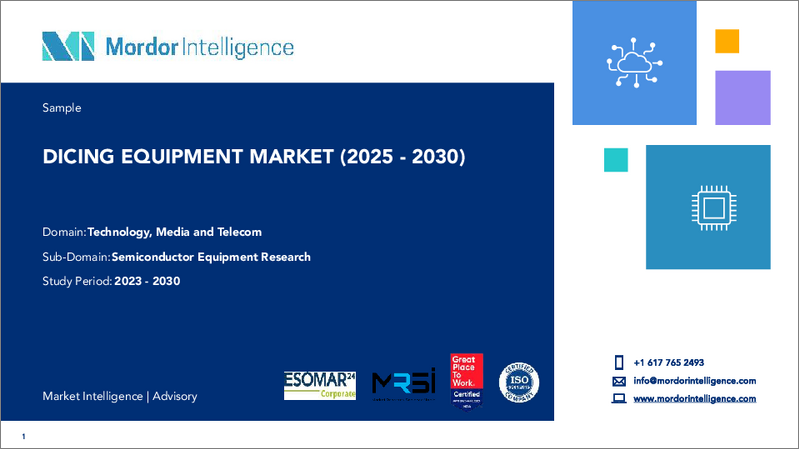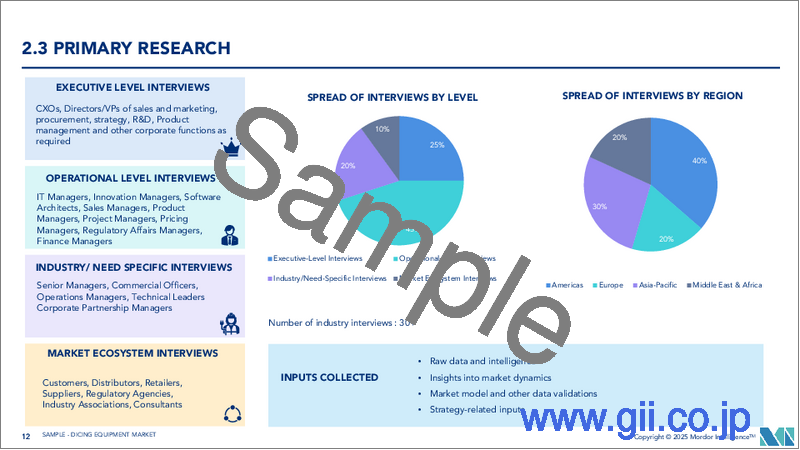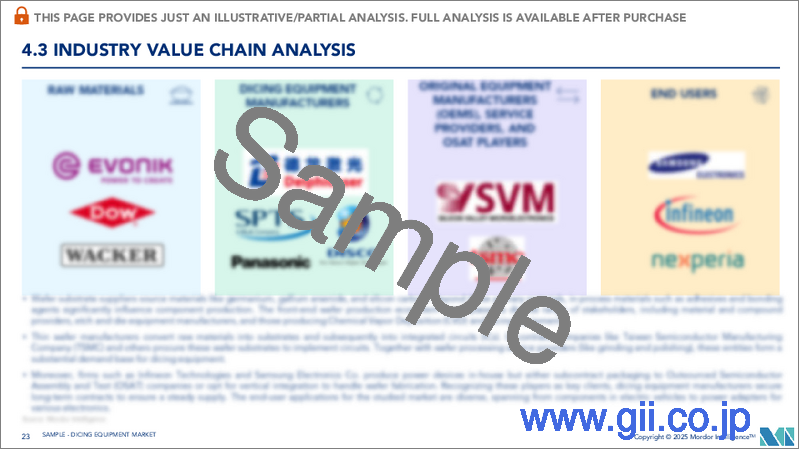|
|
市場調査レポート
商品コード
1644375
ダイシング装置:市場シェア分析、産業動向・統計、成長予測(2025~2030年)Dicing Equipment - Market Share Analysis, Industry Trends & Statistics, Growth Forecasts (2025 - 2030) |
||||||
カスタマイズ可能
適宜更新あり
|
|||||||
| ダイシング装置:市場シェア分析、産業動向・統計、成長予測(2025~2030年) |
|
出版日: 2025年01月05日
発行: Mordor Intelligence
ページ情報: 英文 132 Pages
納期: 2~3営業日
|
全表示
- 概要
- 目次
ダイシング装置市場規模は2025年に7億6,000万米ドルと推定され、予測期間(2025~2030年)のCAGRは6.75%で、2030年には10億5,000万米ドルに達すると予測されます。

ダイシング装置は、半導体製造の精度を確保する上で極めて重要な役割を果たしています。ダイシング装置は、ウエハーから個々のサイコロを切り出す役割を担っています。通常、ダイシングソーは、ダイスとダイスの間にある「ストリート」と呼ばれるウエハーの未使用部分をスライスします。このストリートの幅は一般的に3マイル(約3.6km)あり、その狭さがダイシング装置の重要性を高めています。
主要ハイライト
- 市場促進要因として、スマートカード、RFID(Radio Frequency Identification)技術、車載用パワーICの需要急増が挙げられます。民生用電子機器市場の活況、工場設立の増加、小型化と技術移行の動向と並んで、これらの要因が市場ベンダーに研究開発投資の拡大を促しています。性能を高めながら小型化することに重点が置かれたことで、マイクロ電気機械システム(MEMS)や3D包装などの技術革新が促進されました。これらの領域で進行中の進歩は、市場のダイナミックな性質と技術の進歩に適応する俊敏性を強調しています。
- その結果、産業各社は小型化しても電力レベルを維持できる半導体を開発しています。例えば、NXP Semiconductorsは、電力性能を維持しながら、トランジスタの包装サイズを55%縮小するという驚くべき成果を達成しました。このマイルストーンは、小型包装でも性能を犠牲にすることなく、技術的な限界を押し広げようとする産業の努力を浮き彫りにしています。
- さらに、Diodes Incorporatedは、わずか2mm×2mmのフットプリントを占めるDFN2020包装に格納された2つの車載対応金属-酸化膜-半導体電界効果トランジスタ(MOSFET)を発表しました。このような技術革新は、半導体とIC包装市場の小型化、ダイシング装置に対する需要の増加をさらに加速させています。このような技術革新は、現代の電子機器における小型で効率的な部品へのニーズの高まりに対応するための最重要課題です。
- これらの進歩は、3次元集積回路(3D IC)技術の台頭を促進しました。この技術は、携帯民生用電子機器、センサ、MEMS(Micro-Electro-Mechanical Systems:微小電気機械システム)、工業製品など、スペースに制約のある用途でますます普及しています。この技術は、速度、耐久性、低消費電力、軽量設計、メモリ容量の強化に重点を置き、製品全体の性能を大幅に向上させます。
- 極薄ウエハーハンドリングとダイシング装置のプロセスは、MEMS、化合物半導体、LED、ファンアウトWLP、CMOSイメージセンサ(CIS)、TSV相互接続を利用した新興の3D ICなど、さまざまな半導体用途で重要な役割を果たしています。これらのプロセスは、最終製品の機能と効率に不可欠なウエハーの完全性と性能を保証します。しかしながら、これらのプロセス技術は、ウエハーの安定性の維持、ハンドリング時のダメージの防止、既存の製造システムとの互換性の確保など、特有の課題に直面しています。
- チップの角やエッジの割れや欠けを特徴とするチッピングは、重要な課題です。この問題は、歩留まりの低下や製造プロセスでのコスト増につながります。さらに、ダイシング時には、カーフ幅とストリート幅(後者はダイシングされたウエハーの幅に相当)が80~100μm増加します。その結果、カーフロスが発生し、ウエハのムダにつながります。カーフ幅とストリート幅の増加は、材料を無駄にするだけでなく、ダイシングプロセスの精度と効率にも影響を与えます。
- パンデミックがもたらす課題にもかかわらず、特定の参入企業はウェハーに戦略的投資を行っています。例えば、Okmetic Oyは、フィンランドの施設に数千万ユーロを投資する計画を発表し、コアコンピテンシーに注力しています。シリコンオンインシュレーター(SOI)ウエハーです。パンデミック後の世界のダイシング装置市場における顕著な動向は、自動化と先進的制御技術の採用が増加していることです。このシフトは、効率性と精度を向上させ、ダイシング装置市場の成長を促進すると予想されます。
ダイシング装置市場の動向
パワーデバイス用途セグメントが大きな市場シェアを占める見込み
- パワー半導体デバイスは、パワーエレクトロニクス回路のスイッチや整流器として利用され、予測期間中に大幅な成長が見込まれています。この急成長の主要原動力は、携帯電話や、バッテリー寿命を延ばすために効果的な電力管理が重要なヘルストラッカーなどのポータブル電子機器に対する世界の欲求です。さらに、太陽光発電のような代替エネルギー源の推進や、エネルギー効率の高い発光ダイオード(LED)照明の採用も、こうしたパワーデバイスの需要を後押ししています。
- 用途の進化に伴い、フォームファクターの小型化、スイッチング周波数の高速化、高電圧機能に対する需要が高まっています。この進化は、製品メーカーや処理装置プロバイダーにとって不可欠な集積回路(IC)としてのパワーデバイスの価値を際立たせています。民生用電子機器だけでなく、電気自動車(EV)、データセンター、産業用と民生用 IoT用途などのセグメントでも、半導体デバイスに対する電力要件が進化しています。
- 自動車産業、特に電気自動車の台頭は、再生可能エネルギーや民生用電子機器などのセグメントと並んで、最高レベルの効率的なダイシング装置への需要を高めています。規制機関も重要な措置を講じています。米国運輸省は、企業平均燃費(CAFE)車両基準を設定しました。英国は、2050年までに純排出量ゼロを目指し、2035年までにすべての汚染車の販売を禁止する計画です。ドイツは野心的な目標を設定し、2020年末までに温室効果ガス排出量を40%削減、2030年までに55%削減、2050年までに最大95%削減を目指しています。同時に米国と欧州の政府は、温室効果ガス対策として排出規制を強化しています。こうした協調的な努力は、自動車の燃費向上の推進と並んで、電気自動車、ひいてはパワーデバイスへの需要を増大させています。
- 最新のパワーデバイスは、レーザーダイシングや先進的ブレードダイシング技術のような技術革新の恩恵を受けており、精度と効率が向上しています。例えば、ASMPTはパワー半導体市場向けのソリューションを発表しました。特許取得済みのマルチビームV-DOE技術は、薄い炭化ケイ素(SiC)ウエハー(150μm以下)のダイシング用に設計されています。この改良されたビーム構成により、ダイのポストカットが著しく強化されます。
- 産業の重要な進歩として、Infineonは2024年9月、パワーエレクトロニクス用の世界初の300mm窒化ガリウム(GaN)ウエハー技術を発表しました。この画期的な技術により、効率の向上、小型・軽量化、チップ全体の低コスト化が約束されます。
- 5G、AI、IoT、エッジコンピューティングなどの技術が半導体市場の拡大を推進する中、先進的ダイシング装置の需要が急増しています。SWZDによると、北米と欧州の組織の57%は、情報技術におけるIoT動向を導入しているか、導入を計画しています。
中国が大きな市場シェアを占める見込み
- 中国は、世界的に最も急成長している半導体市場の一つとして際立っています。スマートフォンやコンシューマーエレクトロニクスの需要が急増しているため、多くのベンダーが中国に生産施設を設立しています。さらに、中国政府のイニシアチブは、現地生産ユニットを設立する国際的な参入企業を引き付けています。
- 半導体産業協会は、2024年までに中国の半導体産業は年間1,160億米ドルの収益を上げ、世界市場シェアの17.4%以上を獲得すると予測しています。この予測は、他国の成長率が安定しているとして、中国が力強い成長モメンタムを維持するかにかかっています。予想される成長は、中国の半導体技術への戦略的投資と進歩を強調するものであり、中国を世界市場における重要な参入企業として位置づけています。
- さらに、SEMI(Semiconductor Equipment and Materials International)のデータによると、中国の鋳造産業は多国籍ベンダーと国内ベンダーの両方で構成されているが、国内企業が優位に立つ構えを見せています。中国における240億米ドルのファブプロジェクトのうち、国内企業が大きなシェアを占めると予想されます。
- ウエハー製造には、個々の半導体チップをシリコンウエハーから切り離す重要なプロセスであるダイシングが含まれます。これには、機械的な鋸切断、レーザー切断、スクライビングなどの精密な切断技術が含まれます。そのため、新興諸国におけるウエハー製造施設の開発は、ウエハー加工に使用される様々なダイシング装置の需要を生み出すと予想されます。
- 例えば、2024年11月、北京市は国有企業やファンドの支援を受け、12インチウエハー製造施設に46億米ドルを投資する計画です。この構想は、中国の国内半導体生産強化に向けた継続的な取り組みを浮き彫りにするものです。新施設には、Beijing Yandong Microelectronics(YDME)と中国の大手ディスプレイメーカーであるBOE Technologyが関与しています。
ダイシング装置産業概要
市場における競争企業間の敵対関係とは、産業の既存参入企業間の競争を指します。この競争は、ブランドID確認、競合戦略、透明度、企業の集中度などの要因に影響されます。スマートフォンやスマートウォッチなどのスマートデバイスの台頭は、スマートセンサへの需要に拍車をかけ、結果として先端半導体市場を押し上げています。
メモリや性能の向上を目指して小型化が進んでいることも、小型電子包装の需要に拍車をかけています。その結果、薄型ウエハーが今日の電子機器の小型化において脚光を浴びるようになり、薄型ウエハーの生産量が急増し、それに伴って加工装置やダイシング装置の需要も増加しています。
ダイシング装置市場は、Disco CorporationやPanasonic Corporationなど、少数の大手企業が独占しています。また、ウエハー製造プロセスにおける課題が、新規参入企業の市場参入を遅らせています。
主要参入企業には、Suzhou Delphi Laser、SPTS Technologies Limited(KLA Tencor Corporation)、ASM Laser Separation International(ALSI) BV、Tokyo Seimitsu、Neon Techなどがあります。
その他の特典
- エクセル形式の市場予測(ME)シート
- 3ヶ月のアナリストサポート
目次
第1章 イントロダクション
- 調査の前提条件と市場定義
- 調査範囲
第2章 調査手法
第3章 エグゼクティブサマリー
第4章 市場洞察
- 市場概要
- 産業の魅力-ポーターのファイブフォース分析
- 供給企業の交渉力
- 消費者の交渉力
- 新規参入業者の脅威
- 競争企業間の敵対関係
- 代替品の脅威
- 産業バリューチェーン分析
- 市場に与えるマクロ経済要因の評価
第5章 市場力学
- 市場促進要因
- 技術の進歩、次世代デバイスの進化
- 市場課題
- 大量生産の課題
第6章 市場セグメンテーション
- ダイシング技術別
- ブレードダイシング
- レーザーアブレーション
- ステルスダイシング
- プラズマダイシング
- 用途別
- ロジックメモリ
- MEMSデバイス
- パワーデバイス
- CMOSイメージセンサ
- RFID
- 地域別
- 中国
- 台湾
- 韓国
- 北米
- 欧州
- その他
第7章 ダイシング装置主要顧客リスト
第8章 競合情勢
- 企業プロファイル
- Suzhou Delphi Laser Co. Ltd
- SPTS Technologies Limited(KLA Tencor Corporation)
- ASM Laser Separation International(ALSI)BV
- Tokyo Seimitsu Co. Ltd
- Neon Tech Co. Ltd
- Synova SA
- Panasonic Connect Co., Ltd(Panasonic Holdings Corporation)
- Plasma-Therm LLC
- DISCO Corporation
- 3D-Micromac AG
- Veeco Instruments Inc.
- Advanced Dicing Technologies Limited
- Han's Laser Technology Industry Group Co., Ltd
- EO Technics Co., Ltd.
第9章 投資分析
第10章 投資分析市場の将来
The Dicing Equipment Market size is estimated at USD 0.76 billion in 2025, and is expected to reach USD 1.05 billion by 2030, at a CAGR of 6.75% during the forecast period (2025-2030).

Dicing equipment plays a pivotal role in ensuring precision during semiconductor manufacturing. The equipment is responsible for cutting individual dice from a wafer. Typically, a dicing saw slices through an unused section of the wafer, referred to as the 'street,' which is located between the dice. These streets generally measure three miles in width, and their narrowing heightens the significance of the dicing equipment.
Key Highlights
- Key drivers propelling the growth of the studied market encompass surging demands for smart cards, Radio Frequency Identification (RFID) technology, and automotive power ICs. Alongside a flourishing consumer electronics market, an increase in factory establishments, and a trend towards miniaturization and technology migration, these factors have urged market vendors to amplify their research and development investments. This emphasis on downsizing while boosting performance has catalyzed innovations such as micro-electro-mechanical systems (MEMS) and 3D packaging. The ongoing advancements in these domains underscore the market's dynamic nature and its agility in adapting to technological progress.
- As a result, industry players are developing semiconductors that sustain power levels even with size reductions. For instance, NXP Semiconductors achieved a remarkable 55% reduction in package size for its transistors, all while maintaining power performance. This milestone highlights the industry's dedication to pushing technical boundaries, ensuring that compact packages do not sacrifice performance.
- Furthermore, Diodes Incorporated unveiled two automotive-compliant metal-oxide-semiconductor field-effect transistors (MOSFET) housed in a DFN2020 package, occupying a mere 2 mm by 2 mm footprint. Such strides accentuate the upward trajectory of the miniaturized semiconductor and IC packaging markets, subsequently amplifying the demand for dicing equipment. These innovations are paramount, addressing the escalating need for compact and efficient components in contemporary electronic devices.
- These advancements have catalyzed the ascent of three-dimensional integrated circuits (3D ICs) technology. This technology is becoming increasingly popular in space-constrained applications, spanning portable consumer electronics, sensors, Micro-Electro-Mechanical Systems (MEMS), and industrial products. It significantly boosts overall product performance, emphasizing speed, durability, low power consumption, lightweight design, and enhanced memory capacity.
- Ultra-thin wafer handling and dicing equipment processes play a crucial role in various semiconductor applications, including MEMS, compound semiconductors, LEDs, fan-out WLP, CMOS image sensors (CIS), and the emerging 3D ICs utilizing TSV interconnects. These processes ensure the integrity and performance of the wafers, which are essential for the functionality and efficiency of the end products. Nevertheless, these processing technologies face specific challenges, such as maintaining wafer stability, preventing damage during handling, and ensuring compatibility with existing manufacturing systems.
- Chipping, characterized by the cracking or chipping of the corners and edges of chips, poses a significant challenge. This issue can lead to reduced yield and increased costs in the manufacturing process. Furthermore, during dicing, the kerf width and the street width (the latter corresponding to the width of the diced wafer) increase by 80 to 100 μm. Consequently, this results in a kerf loss, leading to wastage of the wafers. The increased kerf width and street width not only waste material but also impact the precision and efficiency of the dicing process.
- Despite the challenges posed by the pandemic, certain players are making strategic investments in wafers. For example, Okmetic Oy announced plans to invest tens of millions of euros in its Finland facility, focusing on its core competency: Silicon-On-Insulator (SOI) wafers. Post-pandemic, a prominent trend in the global dicing equipment market is the rising adoption of automation and advanced control technologies. This shift is anticipated to enhance efficiency and precision, subsequently driving the dicing equipment market growth.
Dicing Equipment Market Trends
Power Devices Application Segment is Expected to Hold Significant Market Share
- Power semiconductor devices, utilized as switches or rectifiers in power electronic circuits, are poised for substantial growth during the forecast period. This surge is primarily driven by the global appetite for cell phones and portable electronics, such as health trackers, where effective power management is crucial for extending battery life. Additionally, the demand for these power devices is bolstered by the push for alternative energy sources like solar power and the adoption of energy-efficient Light Emitting Diode (LED) lighting.
- As applications evolve, there's a growing demand for smaller form factors, faster-switching frequencies, and higher voltage capabilities. This evolution underscores the value of power devices as essential integrated circuits (ICs) for product manufacturers and processing equipment providers. Beyond consumer electronics, sectors like electric vehicles (EVs), data centers, and both industrial and consumer IoT applications are witnessing evolving power requirements for semiconductor devices.
- The automotive industry, particularly with the rise of electric vehicles, alongside sectors like renewable energy and consumer electronics, is driving a heightened demand for top-tier, efficient dicing equipment. Regulatory bodies are taking significant steps: The US Department of Transportation has established Corporate Average Fuel Economy (CAFE) vehicle standards. The UK aims for net-zero emissions by 2050 and plans to ban the sale of all polluting vehicles by 2035. Germany has set ambitious targets, seeking a 40% reduction in greenhouse gas emissions by the end of 2020, 55% by 2030, and up to 95% by 2050. Concurrently, US and European governments are tightening emission limits to combat the greenhouse effect. These concerted efforts, alongside a push for enhanced vehicle fuel economy, are amplifying the demand for electric vehicles and, in turn, power devices.
- Modern power devices are benefiting from innovations like laser dicing and advanced blade dicing techniques, which offer enhanced precision and efficiency. For example, ASMPT has introduced a solution for the power semiconductor market. Their patented multi-beam V-DOE technology is designed for dicing through thin Silicon Carbide (SiC) wafers (less than 150 µm). This modified beam configuration notably strengthens the die post-cutting.
- In a significant industry advancement, Infineon unveiled the world's first 300mm Gallium Nitride (GaN) wafer technology for power electronics in September 2024. This breakthrough promises enhanced efficiency, reduced size and weight, and a lower overall cost for chips.
- As technologies like 5G, AI, IoT, and edge computing propel the semiconductor market's expansion, the demand for sophisticated dicing equipment has surged. According to SWZD, 57 percent of organizations in North America and Europe have either implemented or plan to implement IoT trend in information technology.
China is Expected to Hold Significant Market Share
- China stands out as one of the fastest-growing semiconductor markets globally. The surging demand for smartphones and consumer electronics is prompting numerous vendors to establish production facilities in the nation. Further, the Chinese government's initiatives are attracting international players to set up local production units.
- The Semiconductor Industry Association forecasts that by 2024, China's semiconductor industry will generate an annual revenue of USD 116 billion, capturing over 17.4% of the global market share. This forecast depends on China maintaining its strong growth momentum, assuming other countries' growth rates remain stable. The anticipated growth underscores China's strategic investments and advancements in semiconductor technology, positioning it as a significant player in the global market.
- Further, Semiconductor Equipment and Materials International's (SEMI) data indicates that while China's foundry industry comprises both multinational and domestic vendors, domestic companies are poised to dominate. Out of the USD 24 billion fab projects in China, domestic firms are expected to command a significant share.
- Wafer fabrication includes dicing, a critical process where individual semiconductor chips are separated from a silicon wafer. This involves precise cutting techniques such as mechanical sawing, laser cutting, and scribing. Thus, the development of new wafer fabrication facilities in the country is expected to generate demand for various dicing equipment used in wafer processing.
- For instance, in November 2024, Beijing, supported by state-owned enterprises and funds, plans to invest USD 4.6 billion in a 12-inch wafer fabrication facility. This initiative highlights China's ongoing efforts to strengthen its domestic semiconductor production. The new facility involves Beijing Yandong Microelectronics (YDME) and BOE Technology, China's leading display manufacturer.
Dicing Equipment Industry Overview
Competitive rivalry in the market refers to the competition among established players in the industry. This competition is influenced by factors such as brand identity, competitive strategies, transparency levels, and the concentration ratio of firms. The rise of smart devices, including smartphones and smartwatches, has spurred the demand for smart sensors, consequently boosting the market for advanced semiconductors.
Factors like the trend towards miniaturization, aiming for enhanced memory and performance in smaller sizes, have spurred demand for compact electronic packages. As a result, thin wafers have gained prominence in today's miniaturized electronics landscape, leading to a surge in thin wafer production and a corresponding demand for processing and dicing equipment.
The dicing equipment market is dominated by a handful of major players, including Disco Corporation and Panasonic Corporation, among others. Additionally, challenges in thin wafer manufacturing processes have slowed the entry of new players into the market.
Some of the major players in the market are Suzhou Delphi Laser Co. Ltd, SPTS Technologies Limited (KLA Tencor Corporation), ASM Laser Separation International (ALSI) BV, Tokyo Seimitsu Co. Ltd, and Neon Tech Co. Ltd.
Additional Benefits:
- The market estimate (ME) sheet in Excel format
- 3 months of analyst support
TABLE OF CONTENTS
1 INTRODUCTION
- 1.1 Study Assumptions and Market Definition
- 1.2 Scope of the Study
2 RESEARCH METHODOLOGY
3 EXECUTIVE SUMMARY
4 MARKET INSIGHTS
- 4.1 Market Overview
- 4.2 Industry Attractiveness - Porter's Five Forces Analysis
- 4.2.1 Bargaining Power of Suppliers
- 4.2.2 Bargaining Power of Consumers
- 4.2.3 Threat of New Entrants
- 4.2.4 Intensity of Competitive Rivalry
- 4.2.5 Threat of Substitutes
- 4.3 Industry Value Chain Analysis
- 4.4 Assessment of Macroeconomic Factors on the Market
5 MARKET DYNAMICS
- 5.1 Market Drivers
- 5.1.1 Technological Advancements, and Evolution of Next Generation Devices
- 5.2 Market Challenges
- 5.2.1 Mass Manufacturing Challenges
6 MARKET SEGMENTATION
- 6.1 By Dicing Technology
- 6.1.1 Blade Dicing
- 6.1.2 Laser Ablation
- 6.1.3 Stealth Dicing
- 6.1.4 Plasma Dicing
- 6.2 By Application
- 6.2.1 Logic & Memory
- 6.2.2 MEMS Devices
- 6.2.3 Power Devices
- 6.2.4 CMOS Image Sensor
- 6.2.5 RFID
- 6.3 By Geography
- 6.3.1 China
- 6.3.2 Taiwan
- 6.3.3 South Korea
- 6.3.4 North America
- 6.3.5 Europe
- 6.3.6 Rest of the World
7 POTENTIAL LIST OF KEY CUSTOMERS FOR DICING EQUIPMENT
8 COMPETITIVE LANDSCAPE
- 8.1 Company Profiles
- 8.1.1 Suzhou Delphi Laser Co. Ltd
- 8.1.2 SPTS Technologies Limited (KLA Tencor Corporation)
- 8.1.3 ASM Laser Separation International (ALSI) BV
- 8.1.4 Tokyo Seimitsu Co. Ltd
- 8.1.5 Neon Tech Co. Ltd
- 8.1.6 Synova SA
- 8.1.7 Panasonic Connect Co., Ltd (Panasonic Holdings Corporation)
- 8.1.8 Plasma-Therm LLC
- 8.1.9 DISCO Corporation
- 8.1.10 3D-Micromac AG
- 8.1.11 Veeco Instruments Inc.
- 8.1.12 Advanced Dicing Technologies Limited
- 8.1.13 Han's Laser Technology Industry Group Co., Ltd
- 8.1.14 EO Technics Co., Ltd.






